Getting to Khiva should have been relatively straight forward—a bus to Urgench and then a 45 minute taxi ride to Khiva. I bought a seat on the local bus to Urgench in Nukus, knowing it might take a little more time than a taxi, but with more space. I was almost an hour early and had to wait with the other passengers inside the bus to reserve my seat. When I asked a man to take a photo of me and the other back seat passengers another man came bounding down the aisle from the front of the bus and literally sat on top of me and the man to my right to make space for himself. As you can see from the photos, I was the only one to be squeezed out because Uzbeks have an amazing ability to take up as much space as possible and not budge. The man grabbed my arm, held it up in the air and then kissed my forearm. I was not too happy with his concept of personal space but he wasn’t moving even though there were other seats toward the front.
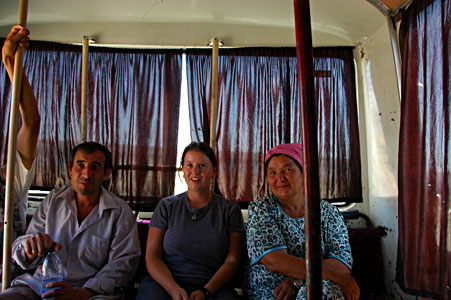
Taking the local bus
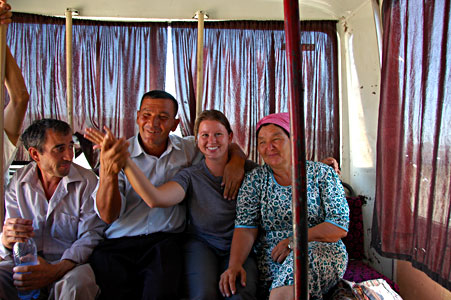
Inappropriate hand placement on the local bus
Luckily, the bus broke down after only 30 minutes and the man next to me went outside to pretend to help. After sitting for another 30 minutes I saw our driver flag down a car and get a ride back to town so I knew it would be another hour at the very least. Soon an even more dilapidated bus pulled over and I somehow slung my heavy bag over my shoulder and ran to catch it before the other passengers filled it up. Most people decided to stay and wait the first bus out but I decided that saving $1.50 was not worth waiting for hours.This bus had a few bags of produce lined along the sides for seats and a group of brightly costumed women sleeping on the floor at the back. A 19 year-old guy next to me took me under his wing and used his limited English ability to promise we were heading to Khiva.
The second bus only went as far as the next town where we got off and waited by the side of the roundabout for a taxi. Two old gold-toothed ladies followed and soon my 19 year-old guide was carrying their bags as well as mine. Our first taxi was a Daewoo Tico—the smallest car in Uzbekistan. It already had a passenger in the front so we had to fit four people in the back of a car about the size of a Mini Cooper. Uzbek women are wider than you would think and with all of our hips we couldn’t even squeeze ourselves onto the bench. So, naturally, I spent the ride sitting on the woman in the middle’s lap. Ducking down, my head hit the ceiling and I felt each bump in the road.
The Tico wasn’t heading all the way to Urgench so we got out again, waited ten more minutes beside the road and found a slightly larger car to squeeze into the back seat. This time the boy sat a bit on my lap, which was slightly more comfortable than being in the middle of an Uzbek–Tico sandwich. We made it into Urgench and started toward the market. Although he wouldn’t let me carry my own bag, the boy gave in and let me carry one strap while he balanced the load with one of the babushka’s bags in the other hand. We walked through the market and had to ask at a few lots to find the shared taxis to Khiva. The boy was great—when the first bus broke down he told me that he would get me to Khiva and he did. Even with all of the taxi and bus changes I still made it to town earlier than I would have had the first bus never broke down, which demonstrates just how damn slow Uzbek buses are.
The taxi ride was uneventful and I got a front seat next to a bag of pig’s hoofs. The glove compartment opened up into my knees ten times before the driver gave up and took the bottle of vodka out so it could close properly. The vodka had been resting right on top of his Muslim skull cap. Despite all of my efforts I was was dropped off at the wrong gate to the old town and wandered around the mud walls until I found a tourist information office to point me toward my hotel. It was 7pm and I hurried to check in and eat before the free fashion show in one of the madressas. The town was just finishing up a two-day festival of free events for tourists which included a fashion show. Unfortunately, despite being billed as traditional costumes, the clothes were only influenced by Uzbek patterns and costumes and included no historic costumes. After the fashion finished we were presented with a brief show of traditional Uzbek singing and dance. One of the men was in his late teens or early 20’s and had an incredible ability to shake his shoulders. That seems to be a large part of the dancing and this man’s shoulders were almost mesmerizing.
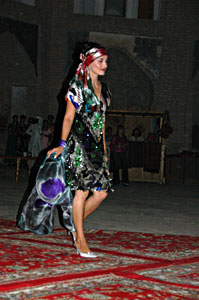
Fashion show
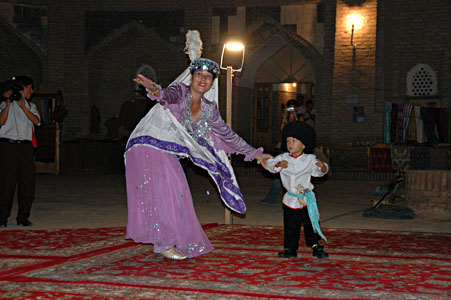
Traditional dance
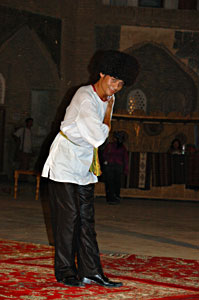
Shoulder-shaking dancer
I only planned on staying in Khiva for one full day because I had been told it is quite small and empty. That turned out to be true and I think one day was enough time to see all of the major buildings around town and get a feel for the way the city once operated. Although the old city is now protected it has lost any character it once had as a major slave trading outpost along the silk road. The 18th century city walls reach three to four stories and include four gateways. The interior buildings are made of the same mud brick material as the walls, and the entire place just feels… empty. Empty and khaki. There are some tiles remaining on the outside of the buildings including a heavily tiles turquoise minaret near the main gate and a lot more decoration inside the structures. Even so, the town is so tightly controlled that there are only a few souvenir sellers in the old town and only a handful seem to be allowed to display anything outside of their kiosks. Normally I would applaud this but because the town is protected the only thing allowed in is souvenirs, no old men with white beards selling watermelons or brightly dressed women carrying baskets of bread around. It’s just empty.

Empty Khiva
My first night in town I had planned a route through town based on the buildings I wanted to see. Starting closest to my hotel I tried to enter a handicrafts center only to be turned away because I didn’t have a ticket. The ticket to visit most of the city had to be bought at the main gate, which was at the end of my planned route. Throwing a tiny tantrum I stomped through town to get my ticket and rearrange my route. The ticket was about $8 and the woman at the gate accepted a ten dollar bill and gave me change in com. Despite the fact that it’s technically illegal to pay for goods in dollars in Uzbekistan everyone accepts dollars, including government institutions. Besides a few hotels, a few cafes and a lot of souvenir shops the city was totally empty. Every once in a while I would turn a corner to stumble upon a French tour group, but for the most part I felt totally alone. After French tour groups the next most common groups seemed to be Spanish and I found a few groups with guides to listen in on for free.
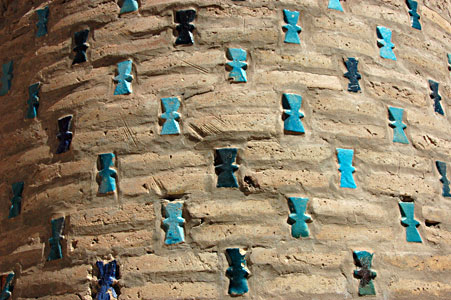
Tiles
After leaving a Spanish group behind I wandered inside the palace to find more courtyards and stumbled upon an Uzbek couple passionately kissing. I went ahead taking pictures around them until they left so I could get a good photo of the elaborately painted ceiling. On the way out I peeked into another room of the main corridor and found them again, this time even more intertwined, and decided to leave before I saw more than I bargained for.

Megan inside the palace
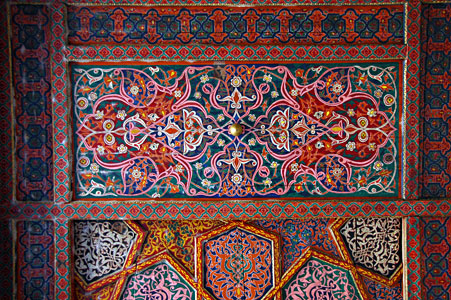
Amazing ceiling
Some of the more important buildings required an additional fee, like the Pahlavon Mohammed Mausoleum with it’s intricately designed tile work and old men praying in front of the money-littered tomb. I think the Juma Mosque was more impressive with it’s 218 carved wooden columns and uncharacteristically-flat roof. I paid a teenage girl 1000 com to be allowed to climb to the top of the tallest minaret in town for a good look over the city. My guidebook said that it afforded views of the surrounding desert but I could only see the modern city sprawling around the old khaki walls.

Wedding
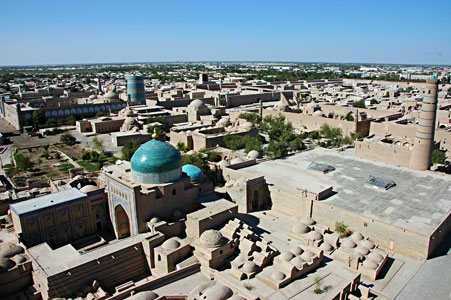
View from a minaret
After I finished visiting the buildings on my self-imposed “tour” I stopped by the main entrance to scout out a location for my cartwheel photo. I waited impatiently for tourist to walk by so I could enlist them in my cartwheel picture-taking but no one seemed to be in the area besides a few locals selling fur hats and embroidered suzannes. Ducking inside one of the cafes I found a young woman named Manzura who spoke good English and was more than willing to take my cartwheel photo. After staring at my example photo in disbelief she asked if Icould really do that and exclaimed that I must be very good at sports. The woman here participate in few physical activities so I suppose I seemed like an athlete to her. Afterward I stayed around the cafe and talked to her about our differences and similarities. She explained that most people have gold teeth to cover up crooked smiles and that the gold caps cost much less than white ones.
At twenty one years old she’s under a lot of pressure to get married and her family is worried since she’s already turned down her boyfriend’s first proposal. She explained that he broke up with her recently because of some gossip he had heard about her being “too Western” and she now refused to get back together with him because he believed the town gossip instead of her. To complicate matters her boss is her boyfriend’s father and a close family friend. I think she’s very brave to stand up to the traditional way of life and I hope that even if she does get married she will be able to use her English skills and university degree in tourism to start a rewarding career. While we were talking we were visited by one of her friends who is pregnant and trying to continue her work as a French tour guide. Unfortunately, once a baby is born an Uzbek woman has to look after it even if she is more educated and earns more money than her husband. Of course, once an Uzbek woman is married she’s as good as pregnant. I also think that abuse is common—I saw a man hit a woman in the face during my stay in Khiva and no one looked twice while I stood in amazement debating what to do about it.
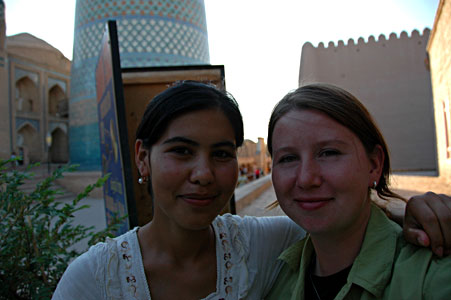
Megan and Manzura

My hair has started to revolt
Khiva was interesting to see because it is so well-preserved but it really lacked the character I you would expect in a Central Asian trading post. It was my first taste of the many madressas, mosques, arks and minarets to come in Bukhara and Samarkand.